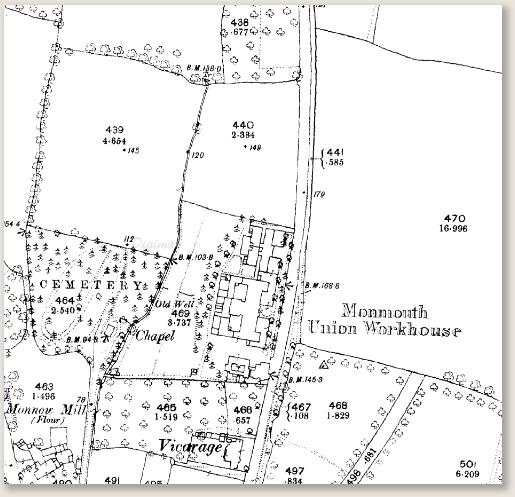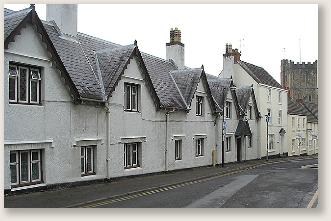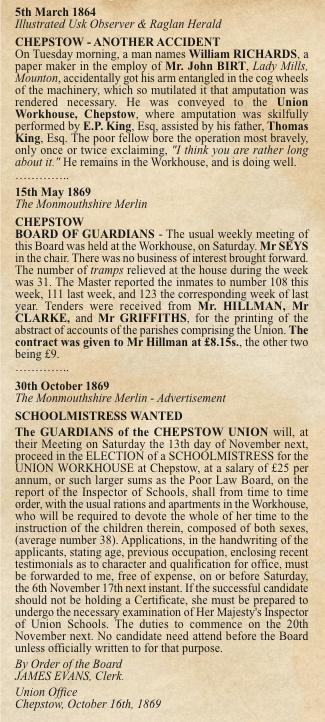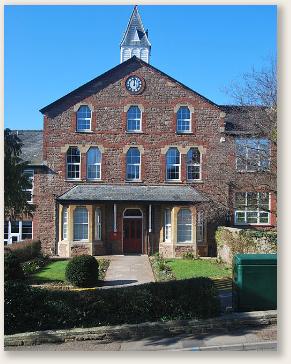

(the following details, unless otherwise stated, are derived from Kelly's 1891 Directory for Monmouthshire, together with the Gwent Archives and Wikipedia websites)
1836 THE CHEPSTOW POOR LAW UNION
Chepstow Poor Law Union was formed in 1836 and operated in constituent parishes of:
Caerwent, Caldicott, Chapel Hill, Chepstow, Cilgwrwg, Dinham, Howick, Ifton, Itton, Llangewydd, Llangwm, Llansoy, Llanvair-Discoed, Llanfihangel Rogiet, Llanfihangel Tor y Mynydd, Martharn, Mounton, Newchurch, Penterry, Portskewett, Rogiet, St Arvans, St Pierre, Shirenewton, Tidenham, Tintern, Trelleck Grange, Undy and Wolvesnewton. (details from Cymru Archives Wales website)
1891:
The Union Workhouse was situated on Mounton Road, Chepstow and was first erected in 1838; it has been enlarged from time to time and is now a commodious suite of buildings and will accommodate 175 inmates. The school (in 1891) is now used as a chapel for the inmates and the children are sent to Board School with satisfactory results. (2013: [The Workhouse building is now used for a Nursery School - "Regent House", Mounton Rd, Regent Way, Chepstow]
The Union in 1891:
Clerk to the Board of Guardians & Assessment Committee: James Fothergill Evans, Bank Buildings, Chepstow
Treasurer: Charles William Loftus Digby, London & Provincial Bank, Chepstow
Relieving & Vaccination Officers:
Chepstow District: Samuel Gwynne Watkins, St. Arvans
Lydney District: Thomas Rees Steel, Woolaston
Shirenewton District: Joseph Rymer, Itton
Inquiry Officers:
Lydney & Shirenewton: Joseph Rymer, Itton
Chepstow: William Williams, Pembroke House, Back St., Chepstow
Medical Officers:
Caldicot District: Arthur Crosbee Dixey, The Grove, Caldicot
Chepstow & Shirenewton Districts: Edward Pendril King, Chepstow
Lydney District: Tyler Pleydell Carter L.R.C.P.Lond., Lydney
Tintern District: John Taylor Brown M.B, C.M, Tintern Parva
Public Vaccinators:
Chepstow & Shirenewton, Lydney & Tintern: (same Medical Officers above)
Caldicot District: Arthur Garnons Lawrence M.B, The Cedars, Welsh St., Chepstow
Superintendent Registrar: James Fothergill Evans, Bank Buildings
Deputy: Thomas Evans, Bank Buildings, Chepstow
Registrars of Marriages:
Samuel Gwynne Watkins, St. Arvans
Deputy: Thomas Sargent, 21 Bridge St. Chepstow
Joseph Rymer, Itton
Deputy: William Till, Caerwent, Thomas Rees Steel, Woollaston
Registrars of Births & Deaths:
Chepstow Sub-District: Samuel Gwynne Watkins, St. Arvans
Deputy: Thomas Sargent, 21 Bridge St., Chepstow
Lydney Sub-District: Thomas Rees Steel, Woollaston
Shirenewton Sub-District: Joseph Rymer, Itton
Deputy: William Till, Caerwent
THE CHEPSTOW WORKHOUSE:
Mounton Road, Chepstow
Staff in 1891:
Workhouse Master: Thomas William Steel
Chaplain: Rev. Joseph Frederick Jones, of Devauden
Medical Officer: E.P. King
Matron: Mrs. Thomas William Steel
The Population of the Union in 1881 was 18,657; rateable value in 1890, £133,850.
Chepstow Board of Guardians Records
www.gwentarchives.gov.uk/media/6969/cswbgc.html
…………..
The Parish of MONMOUTH -
The condition of the Poor before the formation of the Union
Sir Frederick Morton Eden, in his 1797 Report "State of the Poor" describes Monmouth in 1795:
"This Parish is said to be a square of about one mile and a quarter: the population has never been taken. The inhabitants are shop-keepers, inn-keepers, agriculturists, &c. Here is one Catholic, and one Methodist congregation. 351 houses pay the Window-Tax; 30 are stated in the surveyor's books as exempted; and the officer thinks 30 or 40 more may be exempted.
The prices of provisions are: beef, 3.3/4d. to 4.1/2d. the lb.; mutton, 4d. to 4.1/2d.; veal, 6d. to 7d.; bacon, 10d. to 1s.; fresh butter, 1s.; salt (butter) 9d. the lb.; potatoes, 8d. a peck; bread, 8d. the quartern loaf, or 5.1/2lb. for 1s.; coals, 12s. the ton; wheat, 11s.6d. to 12s. for 10 gallons; barley, 4.6d. to 5s. for 10 gallons; oats, 4s. for ditto; 1.1/2d. the quart.
The wages of common labourers are, 1s. a day, and victuals; or 1s.6d. with only a dinner. There are 45 ale-houses in this parish; and five Friendly Societies each of which has about 80 members; all of them have had their rules confirmed. One of these Societies is somewhat singular; the members each pay a guinea a year into a box, for which a provision is made for their widows; a copy of their rules could not be obtained.
The rent of land, near the town, is from £3. to £4.10s. an acre; but, at a distance, about £1. an acre. The farms let from £25. to £250. a year; wheat, barley, and oats, are cultivated here in some degree; but the greatest part of the land is chiefly in grass. The Tithes belong to the Duke of Beaufort, and are compounded for. The Land-Tax amounts to £354.10d. and is collected at about 1s.2d. in the pound. There is no common nor waste land in the parish.
The Poor are partly maintained in a Work-House, and partly at home: there are 24 persons, at present, in the Work-house; of which 3 are children, under 7 years of age; 12, between 7 and 30; and 9. between 30 and 79 years old. They are chiefly employed in manufacturing linen and woollen cloaths for the house. The (Work) House is convenient, and well aired, and appears to be kept very clean: the beds, which are good, are furnished with coarse sheets: there are no blankets at present; but some are preparing against next winter. 45 out-pensioners receive, at present, £3.18s.3d. a week; 4 or 5 receive occasional relief. It is supposed that the Poor of this parish do not really cost the parish more than 1s. in the pound on the fair rental: yet it is generally thought that the Rates are high. Several people belonging to the parish are employed in fisheries on the river Wye, on which Monmouth is situated, and in navigating barges to and from this place.
The following is the Bill of Fare in the (Work) House:
Sunday:
Breakfast: Milk pottage; Dinner: Meat and vegetables; Supper: Bread and beer
Monday:
Breakfast: Broth; Dinner Bread and cheese; Supper: Bread and beer
Tuesday: as Sunday
Wednesday: As Monday
Thursday: As Sunday
Friday: As Monday
Saturday: As Sunday
Statement of a Labourer's Earnings and Expenses:
Samuel Price, a labourer, 52 years old, has a wife and 9 children,
viz. a girl aged 17, who is subject to fits, and not able to work; a boy, aged 16, at service; a boy, 15, at home; another boy, 14, at home; 3 girls, 12, 10, and 8 years old; a boy, 3, and another boy, 1.1/2 years old; the wife is now pregnant.
The father, mostly works for a gentleman at 8s a week, and beer; except in hay and corn harvest, when he has 1s.6d. a day, and victuals; annual amount about £21.3s.0d.
The boy, who is 15 years old, earns, by going on errands, &c. about 1s. a week - annually £2.12s.0d
The other children earn nothing, but pick sticks for fuel in the winter
The wife earns, by baking bread for sale, annually about £1.5s.0d
Total income: £25.0s.0d.
Expenses:
The man says, bread at present costs him about 9s. a week throughout the year, and that he could use more if he could get it: annual cost - £23.8s.0d
Butter and cheese, about 6d. a week; he uses neither meat nor beer: £1.6s.0d
Tea and sugar, about 4d. a week: £0.17.4d
Potatoes, 6d a week: £1.6s.0d.
Fuel, a week: 8s.8d.
House-rent, a week: £2.2s.0d
Soap, candle, thread, &c. about: £1.6s.0d.
Total Expenses: £30.14s.0d.
Here appears a deficiency of £5.14s.; yet, the man says, his children mostly go without shoes and stockings, and that the cloaths worn by him and his family are, mostly, if not wholly, given them by charitable people. The gentleman, for whom this labourer works, allows him about 3 pints of milk a day, which, with a little bread, serves his children for breakfast; his wife drinks tea: their dinner is, bread, potatoes, and salt, sometimes a little fat or dripping, if it can be procured cheap: their supper, generally, bread, or potatoes. The man says, his family is little more than half supplied with what they could eat. He rents his house of the Corporation of Monmouth, at 2 guineas a year; but not being able to pay his rent, he says, they lately seized on all his working tools, some of his furniture, &c.: he applied to the parish for relief: which they offered, on condition that he would come into the Poor-House with all his family; which he has hitherto refused to do. From farther enquiry, it appears that the man is honest and industrious. He is determined to remain in his house, in defiance of the Corporation. His children, having been bred up in idleness, and in the most abject, illiterate state, (although several of them have been in service), are so saucy, that no person will employ them.
In this town there are 20 Alms-houses, 10 for men, and 10 for women, each of whom receives 3s.6d. a week, and 15s. a year for coals; and one suit of cloaths every 2 years: 16s. a week are paid for Militia-men's families.
In 1792 the Total Income from the Poors Rate was £381.18s.1d and the Rate in the Pound was 5s.od.
From the information of the Gentlemen of the Town it appears, that, for some years back, the affairs of the parish have been badly managed, and that their books are in great confusion.
In the above account are included the sums paid to the County stock and for building a Gaol, &c.; but the precise sums, thus expended, could not be ascertained.
The people complain, that the farmers do not bring their corn to market, and ascribe the high price of corn to "badgers", or corn-dealers. In the neighbouring Forest of Dean, colliers collected together by thousands,, and came to Monmouth market, where they obliged the farmers to sell their corn at a reasonable price, on which account a party of Dragoons have been stationed here for some time." (dated, November, 1795)
(the above is transcribed from Eden's 1797 "State of the Poor" - Google Books)
The Monmouth Poorhouse referred to in the above 1795 report was in Weirhead Street. The building dated from 1760. It was Monmouth's Workhouse for about 100 years. The parish gave up the control of the workhouse in 1836 when it became the Union Workhouse. As the Union work house it provided accommodation for up to around thirty parishes in the surrounding area including Gloucestershire and Herefordshire. In the time it was a parish workhouse, inmates would have known each other and families stayed together. When it became the Union workhouse occupants were usually strangers; and husbands, wives and children were separated. The building was old and space was cramped which led to violent behaviour by inmates. (some details from Wikipedia)

![]()
![]()
![]()
1836 THE MONMOUTH POOR LAW UNION
Monmouth Poor Law Union was formed in 1836 and operated in constituent parishes of:
Crick, Cwmcarvan, Dingestow, Dixton, English Bicknor, Ganarew, Llandenni, Llandogo, Llangattock-Vibon-Avel, Llangovan, Llanishen, Llanrothal, Llantillio Crossenny, Llanvihangel-Ystern-Llewern, Mitchel Troy, Monmouth, Newland, Park Grace-Dieu, Penallt, Penrhos, Pen-y-clawdd, Raglan, Rockfield, St. Maughans, Skenfrith, Staunton, Tregare, Trellech, Welsh Bicknor, Welsh Newton, Whitchurch and Wonastow, in Monmouthshire; and English Bicknor, Newland, West Dean, Staunton in Gloucestershire. (details from Cymru Archives Wales website)
The Monmouth Union took over the existing Monmouth Parish workhouse at Weirhead Street in 1837. In 1870 a new Monmouth Union Workhouse was built to accommodate 200 inmates. It was located on the West side of Hereford Road and consisted of four blocks of buildings: The Lodge, a receiving building with a dining hall & chapel in the centre, and an Infirmary and is arranged to hold 204 inmates: The Infirmary building is well appointed and has spacious airing grounds: in the rear of this building is a detached fabric for infectious cases: the whole of the buildings are of stone, inclosed with a low wall and palisading. The buildings cost £10,000 to build by H. P. Bolt & Co, Newport, and were designed by G C Haddon of Hereford.
The new building was opened on the Hereford road in 1871. The new union workhouse was an unhappy place. Discipline was strict. The cane was used on all including the very young and the very old. solitary confinement regimes were also in place. Assaults of staff members were common and publicised quite often. Misfortune was rarely taken into account when punishment was dished out. There was also controversy regarding tenders and monopolies on goods and services provided to the workhouse. Undertakers complained of a single provider of coffins which were quite often converted fruit boxes from Birmingham. There was also a failure to distinguish local misfortune with habitual vagrancy. Some local people set up a an Anti-Mendacity society in order to dissuade people from giving money and food to tramps. In 1900 the Guardians of Monmouth Workhouse decided there would be no extra treats at Christmas to avoid the impression that the Union was a charitable institution. The same year the Monmouthshire Beacon newspaper reported inmates were refusing to work at the Union, in order to be sent to the Gaol at Usk, in which conditions were an improvement on the Union. In 1885 the workhouse came under attack when the Guardians found "One Gallon of Gin" on the books with £60 spent on liquor by the Workhouse Master who maintained that it was medicinal. However the secretary of the Western Temperance League worked out that the 167 inmates of the Monmouth Union must have consumed as much wine and spirits as 20,542 less fortunate inmates elsewhere.
THE MONMOUTH WORKHOUSE:
Weirhead Street (until 1870) then at Hereford Road
Staff in 1891:
Master: Ben Whittington
Chaplain: Rev. W.M. Warlow M.A.
Medical Officer: Thomas Gilbert Prosser
Matron: Mrs. Fanny Whittington
The population of the Monmouth Union in 1881 was 30,338; rateable value in 1890, £118,500.
The Workhouse ceased operating sometime after 1932 and the buildings at Hereford Road now form part of the classroom complex for Haberdashers' Monmouth School for Girls.
Monmouth Board of Guardians Records









